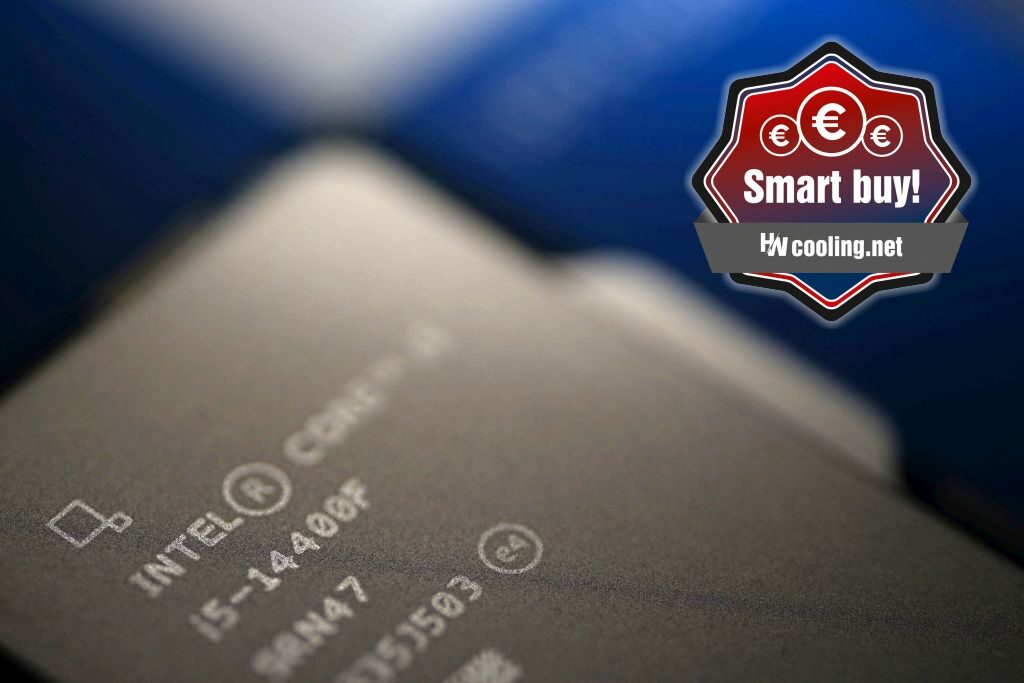Conclusion
Also on the list of lower-power Intel Raptor Lake Refresh processors with 65W TDP is the Core i5-14400F. That is, a model that, mainly because of its attractive price-performance ratio, often ends up in lower-budget PC builds. In the 14th generation, Intel sped up the single-core boost and also E cores. And there are more changes in the small details. For example, the fact that different steppings built on different silicon are again common in e-stores.<!–more→
Conclusion
For a general conclusion on the Core i5-14400F, the evaluation from the Core i5-13400F review would also be applicable. They’re very similar processors, and it’s also true of the Core i5 Raptor Lake Refresh that it has the edge over AMD’s Ryzen 5 7600 in terms of multi-threaded performance. Exactly how much depends on the specific application or the scaling of the E cores.
The efficient (E) cores make the Core i5-14400F a processor that not only has a top-notch price/performance ratio at relatively high speeds, but is also efficient. At least as efficient as the Ryzen 5 7600, and we can assume it can be even more. This is on the basis that the tested stepping B0 (Raptor Lake Refresh) is less efficient at higher load compared to C0 silicon even in the 13th generation, of which we have a detailed analysis. The Core i5-14400F stepping C0 could thus possibly pull ahead of the Ryzen 5 7600 in terms of efficiency this time around as well. We’ll address this in later tests, where we’ll traditionally pit the two steppings against each other.
In terms of intergenerational comparison, there isn’t much of an increase in speed. The E cores (at 3.5 GHz) are indeed 200 MHz faster, but the all-core boost of the P cores (4100 MHz) is unchanged. A more significant speed increase is in single-threaded tasks, where processors with TB 2.0, which is what the Ci5-14400F also is, have long lagged behind Ryzens (5) from the same class. That’s because of the more conservative single-core clock speeds, which have now been increased a bit (by 100 MHz). As a result, a 2–6% increase in speed over the Ci5-13400F can be observed in single-threaded tasks. But it’s still often not enough to keep up with the Ryzen 5 7600, even in web environments, or in office applications that tend to depend on single-threaded performance. The AMD processor is a bit more nimble here, but only by a hair. But with a direct competitor (in price and features, without an iGPU – the Ryzen 5 7500F), it’s already going to be a tie.
But for some, Intel’s dominance in multi-threaded tasks may weigh more heavily in the selection process. And while, as mentioned, the Ci5-14400F is a rather slower processor than the Ryzen 5 7600 in single-threaded tasks, it should be noted that it is so at a higher power efficiency. It is some 7–10% more efficient than the Ryzen 5 7600. In this respect, AMD’s chiplet design with a separate I/O chip, which increases power draw is kind of the culprit . Sooner or later, we’ll find out how this compares to the Ryzen 5 7500F, if anyone has the legitimate complaint while reading the review that we’re putting CPUs side by side that aren’t exactly in direct competition.
The Core i5-13400F’s gaming performance is rather lower compared to the Ryzen 5 7600, due again to significantly lower all-core boost clock speeds, while the efficiency is comparable. However, the Intel processor heats up less due to faster heat transfer at the same power draw, allowing it to be used with a weaker and cheaper cooler. But even the Ryzen 5 7600 doesn’t need to be cooled significantly more intensely to avoid temperatures that will throttle CPU core clock speeds at any boost (single-core one is theoretically critical).
In certain games, as with the Core i5-13400/F, the activity of the E cores can cause performance drops, which we also addressed in this thematic test.This is typically due to situations where a more difficult task is computed on a weaker (E) core instead of a stronger (P) one. And with the Core i5-14400F, there’s one more specificity that has to do with the higher clock speeds on the E cores. Because of these, the clock speeds on the P cores are sometimes affected, which are also lower compared to the Ci5-13400/F. For example, in Total War Saga: Troy, a multiplier of 41 is less frequently applied. This also contributes to the fact that the Ci5-14400F doesn’t usually have higher gaming performance than the Ci5-13400F, and across multiple games you can talk about the same overall level. A similar phenomenon, of course, also occurs outside gaming. The weaker results of the Ci5-14400F SRN47 (stepping B0) may also be due to the slightly worse memory sub-system test results. You may have already noticed these in the Core i5-13400F tests, where the stepping C0 shows higher bandwidth at multiple levels.
The more aggressive power supply of the E cores probably also translates to higher idle power draw, where the Ci5-14400F no longer achieves the extremely power-efficient performance of the Ci5-13400F, although the multiplier on the P cores equally drops to 4 (400 MHz). However, the approximately 11 W can still be praised. The Ryzen 5 7600 is significantly worse in this regard.
Although we’ve devoted quite a bit of space in the text of the review to minor downgrades compared to the last generation, the Core i5-14400F is still a processor with an exceptional value for money, with a slightly higher single-threaded performance at the same price, and with DDR4 memory, even the comparable platform with the Ryzen 5 7500F won’t be any cheaper.The “Smart buy!” award is thus very much fitting.
English translation and edit by Jozef Dudáš
| Intel Core i5-14400F |
| + As many as 10 cores and 16 threads |
| + Higher multi-threaded performance compared to R5 7600 |
| + Attractive price/performance ratio (especially multi-threaded) |
| + High single-threaded performance. Higher than Core i5-13400F |
| + High power efficiency regardless of load intensity |
| + Low idle power draw |
| + Very high performance per clock |
| + The modern 7nm manufacturing node |
| + Low temperatures |
| + Sometimes, top-notch gaming performance... |
| - ... but in some games, due to the E cores slowing it down, lower than the Core i5-12400(F) |
| - Significantly slower than the Ryzen 5 7600 in single-threaded tasks |
| - No integrated GPU |
| Approximate retail price: 196 EUR |
We are grateful to Datacomp e-shop for cooperation in providing the tested hardware
Special thanks also to Blackmagic Design (for DaVinci Resolve Studio license), Topaz Labs (for DeNoise AI, Gigapixel AI and Sharpen AI licenses) and Zoner (for Photo Studio X license)
- Contents
- Intel Core i5-14400F in detail
- Methodology: performance tests
- Methodology: how we measure power draw
- Methodology: temperature and clock speed tests
- Test setup
- 3DMark
- Assassin’s Creed: Valhalla
- Borderlands 3
- Counter-Strike: GO
- Cyberpunk 2077
- DOOM Eternal
- F1 2020
- Metro Exodus
- Microsoft Flight Simulator
- Shadow of the Tomb Raider
- Total War Saga: Troy
- Overall gaming performance
- Gaming performance per euro
- PCMark and Geekbench
- Web performance
- 3D rendering: Cinebench, Blender, ...
- Video 1/2: Adobe Premiere Pro
- Video 2/2: DaVinci Resolve Studio
- Graphics effects: Adobe After Effects
- Video encoding
- Audio encoding
- Broadcasting (OBS and Xsplit)
- Photos 1/2: Adobe Photoshop and Lightroom
- Photos 2/2: Affinity Photo, Topaz Labs AI Apps, ZPS X, ...
- (De)compression
- (De)encryption
- Numerical computing
- Simulations
- Memory and cache tests
- Processor power draw curve
- Average processor power draw
- Performance per watt
- Achieved CPU clock speed
- CPU temperature
- Conclusion










